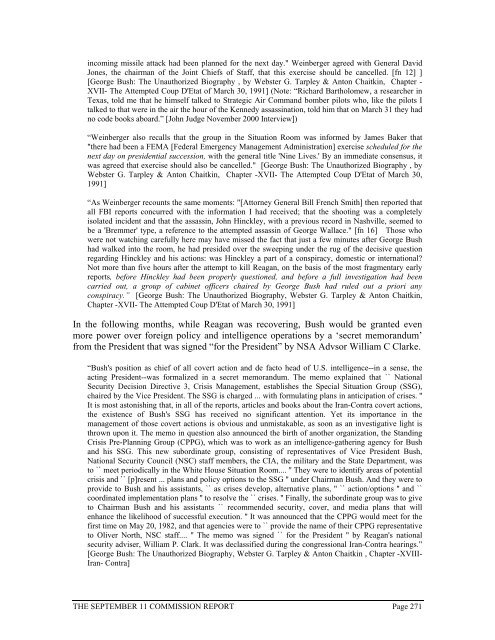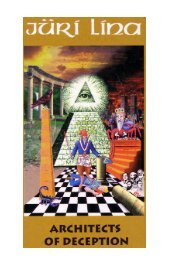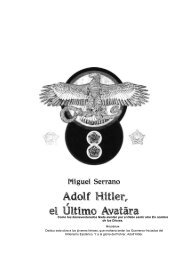September 11 Commission Report - Gnostic Liberation Front
September 11 Commission Report - Gnostic Liberation Front
September 11 Commission Report - Gnostic Liberation Front
Create successful ePaper yourself
Turn your PDF publications into a flip-book with our unique Google optimized e-Paper software.
incoming missile attack had been planned for the next day." Weinberger agreed with General David<br />
Jones, the chairman of the Joint Chiefs of Staff, that this exercise should be cancelled. [fn 12] ]<br />
[George Bush: The Unauthorized Biography , by Webster G. Tarpley & Anton Chaitkin, Chapter -<br />
XVII- The Attempted Coup D'Etat of March 30, 1991] (Note: “Richard Bartholomew, a researcher in<br />
Texas, told me that he himself talked to Strategic Air Command bomber pilots who, like the pilots I<br />
talked to that were in the air the hour of the Kennedy assassination, told him that on March 31 they had<br />
no code books aboard.” [John Judge November 2000 Interview])<br />
“Weinberger also recalls that the group in the Situation Room was informed by James Baker that<br />
"there had been a FEMA [Federal Emergency Management Administration] exercise scheduled for the<br />
next day on presidential succession, with the general title 'Nine Lives.' By an immediate consensus, it<br />
was agreed that exercise should also be cancelled." [George Bush: The Unauthorized Biography , by<br />
Webster G. Tarpley & Anton Chaitkin, Chapter -XVII- The Attempted Coup D'Etat of March 30,<br />
1991]<br />
“As Weinberger recounts the same moments: "[Attorney General Bill French Smith] then reported that<br />
all FBI reports concurred with the information I had received; that the shooting was a completely<br />
isolated incident and that the assassin, John Hinckley, with a previous record in Nashville, seemed to<br />
be a 'Bremmer' type, a reference to the attempted assassin of George Wallace." [fn 16] Those who<br />
were not watching carefully here may have missed the fact that just a few minutes after George Bush<br />
had walked into the room, he had presided over the sweeping under the rug of the decisive question<br />
regarding Hinckley and his actions: was Hinckley a part of a conspiracy, domestic or international?<br />
Not more than five hours after the attempt to kill Reagan, on the basis of the most fragmentary early<br />
reports, before Hinckley had been properly questioned, and before a full investigation had been<br />
carried out, a group of cabinet officers chaired by George Bush had ruled out a priori any<br />
conspiracy.” [George Bush: The Unauthorized Biography, Webster G. Tarpley & Anton Chaitkin,<br />
Chapter -XVII- The Attempted Coup D'Etat of March 30, 1991]<br />
In the following months, while Reagan was recovering, Bush would be granted even<br />
more power over foreign policy and intelligence operations by a ‘secret memorandum’<br />
from the President that was signed “for the President” by NSA Advsor William C Clarke.<br />
“Bush's position as chief of all covert action and de facto head of U.S. intelligence--in a sense, the<br />
acting President--was formalized in a secret memorandum. The memo explained that `` National<br />
Security Decision Directive 3, Crisis Management, establishes the Special Situation Group (SSG),<br />
chaired by the Vice President. The SSG is charged ... with formulating plans in anticipation of crises. ''<br />
It is most astonishing that, in all of the reports, articles and books about the Iran-Contra covert actions,<br />
the existence of Bush's SSG has received no significant attention. Yet its importance in the<br />
management of those covert actions is obvious and unmistakable, as soon as an investigative light is<br />
thrown upon it. The memo in question also announced the birth of another organization, the Standing<br />
Crisis Pre-Planning Group (CPPG), which was to work as an intelligence-gathering agency for Bush<br />
and his SSG. This new subordinate group, consisting of representatives of Vice President Bush,<br />
National Security Council (NSC) staff members, the CIA, the military and the State Department, was<br />
to `` meet periodically in the White House Situation Room.... '' They were to identify areas of potential<br />
crisis and `` [p]resent ... plans and policy options to the SSG '' under Chairman Bush. And they were to<br />
provide to Bush and his assistants, `` as crises develop, alternative plans, '' `` action/options '' and ``<br />
coordinated implementation plans '' to resolve the `` crises. '' Finally, the subordinate group was to give<br />
to Chairman Bush and his assistants `` recommended security, cover, and media plans that will<br />
enhance the likelihood of successful execution. '' It was announced that the CPPG would meet for the<br />
first time on May 20, 1982, and that agencies were to `` provide the name of their CPPG representative<br />
to Oliver North, NSC staff.... '' The memo was signed `` for the President '' by Reagan's national<br />
security adviser, William P. Clark. It was declassified during the congressional Iran-Contra hearings.”<br />
[George Bush: The Unauthorized Biography, Webster G. Tarpley & Anton Chaitkin , Chapter -XVIII-<br />
Iran- Contra]<br />
THE SEPTEMBER <strong>11</strong> COMMISSION REPORT Page 271







